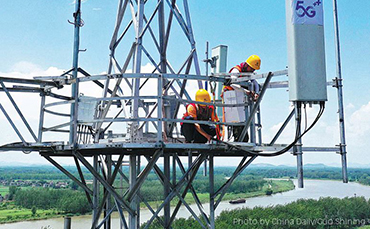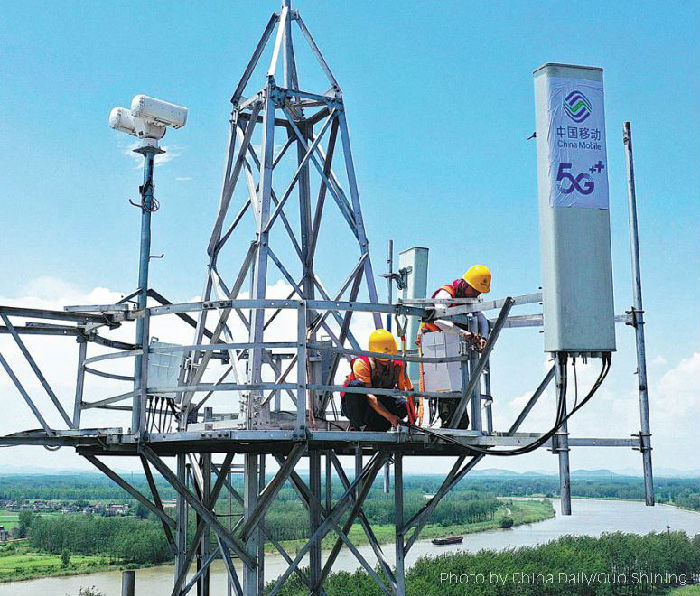



China Mobile employees test a 5G base station in Tongling, Anhui province. [China Daily/Guo Shining]
4. Promote the construction of the new type of cities.
Adhere to the philosophy that all cities must be built and developed on the people-centered principle, following the new urban development trends to accelerate the transformation of urban development, and build livable, resilient, smart, green, and cultural cities.
4.1 Increase the supply of public services universally available.
Scientifically map out compulsory education schools, promote high-quality, well-balanced development of compulsory education, increase the proportion of public compulsory education schools, and strengthen the construction of high schools. Gradually improve the medical care of public hospitals as well as the services of public elderly care institutions. Develop public kindergartens with efforts, and support the private kindergarten to provide affordable services while increasing the capacity of public accessible kindergartens to enroll. Promote the elderly and young friendly renovation of public facilities, and accelerate the development of barrier-free environments. Coordinate the development of living services, carry out high-quality livable city action, and create a convenient life circle within 15 minutes.
4.2 Improve public infrastructure facilities.
Optimize the network layout of bus and subway stations, and remove obstacles in the development of the public transport network. Promote the construction of underground pipe networks such as water, electricity, gas, heat, and telecom, promote the construction of integrated underground utility tunnels in qualified new urban areas and development zones, and encourage the underground laying of overhead pipelines of electricity and telecom in cities with conditions. And reinforce the management of urban landscape lighting to save energy.
4.3 Improve the urban housing system.
Establish a mechanism for housing in line with land and implement a prudent management system for real estate finance. Foster and develop the housing rental market, speed up the regulation releasement in terms of housing rental, and strengthen the supervision of the housing rental market. Improve the support of basic systems and policies for housing and increase the supply of government-subsidized rental housing. Reform and improve the housing fund system, and improve the deposit, utilization, management, and operation mechanism.
4.4 Promote urban regeneration step by step.
Focus on promoting the renovation of old residential communities, old factory areas, old blocks, and villages in cities in old towns, and explore the urban regeneration mode with government leadership, market operation, and public participation. Put more efforts into renovating and revitalizing existing buildings, prevent large-scale demolition and construction, avoid arbitrary demolition of historic buildings, relocation of residents, and felling of ancient trees.
4.5 Bolster capacities to prevent and mitigate disasters.
Identify potential risks on time, and improve disaster monitoring systems and early warning and forecasting systems. Improve and implement the system of accountability for workplace safety, and establish a system for public safety inspections to identify and tackle potential problems as well as safety prevention and control.
4.6 Develop a public health system with early warning and response mechanisms.
Strengthen the capacity-building of institutions for disease prevention and control, build at least one level II biosafety lab in prefecture-level cities, improve epidemic detection and increase the handling capacities of the county-level center for disease control and prevention, and equip the primary-level clinics with personnel engaged in public health work. Improve the ability to deal with epidemics during ordinary days, reserve emergency space, and ensure that new and renovated large public facilities are qualified for rapid transformation into medical rescue and quarantine places.
4.7 Intensify efforts to manage road waterlogging in cities.
The renovation and regeneration of old towns should make up for the shortcomings such as flood control and drainage infrastructure according to the relevant standards, and eliminate the areas that are very prone to waterlogging that had severe impacts on production and living in cities historically. Plan and construct the new urban areas with high standards, and avoid floods and road waterlogging in cities. Intensify the capacity-building of flood monitoring, forecasting and control, improve the layout of embankments and revetments, and build flood intercepting ditches and other facilities in areas where prone to mountain torrents to hold back floodwater into cities.
4.8 Promote the renewal of the infrastructure system and the construction of underground utility tunnels.
Guide localities to coordinately promote the construction of underground utility tunnels in the old urban pipe network renewal work process, develop trunk and branch utility tunnels based on the functional needs in new urban areas, rationally arrange the layout of utility tunnels and coordinate the pipelining of various pipes. Improve the regular management and protection mechanism for the infrastructure system to ensure the stable operation of public facilities.
4.9 Strengthen innovation and entrepreneurship abilities.
Develop the innovation functions such as national independent innovation demonstration zones, high-tech industrial development zones, and economic and technological development zones. Promote scientific research platforms and data open to enterprises, and encourage large enterprises to share resources, scenarios, and needs with medium and small companies. Improve the efficiency of supervision, and establish a comprehensive, tiered, and multifaceted system to regulate all stages, from start to finish, in all sectors.
4.10 Promote smart transformation.
More efforts are needed to accelerate the rollout of 5G networks, ensure that the 5G signals will cover all cities and counties across the nation to increase the penetration rate, and expand the coverage of the gigabit optical network. And enrich the application scenarios of digital technologies, and promote the development of remote work, online education, telemedicine, smart travel, smart communities, smart buildings, smart business districts, smart security and other industries.
4.11 Strengthen ecological restoration and environmental protection.
Adhere to the integrated protection and systematic management of mountains, rivers, forests, farmlands, lakes, grasslands, and deserts, promote the enforcement of red lines for ecological conservation, set benchmarks for environmental quality, impose caps on resource utilization, and implement the requirements of access list for the ecological environment to improve the quality and stability of the ecosystem. And build ecological buffer zones to preserve the ecological safety distance.
4.12 Promote a low-carbon approach to life and work.
Achieve carbon peak and carbon neutrality, promote clean, low-carbon, safe, and highly efficient use of energy, encourage non-fossil energy consumption, replace coal with electricity and gas, develop distributed renewable energy such as rooftop photovoltaic initiatives, advance combined heat and power (CHP) central heating in cities, promote the application of residual heat from production processes, heat pumps, and other clean heating methods based on local conditions, and implement energy-saving management such as Energy Performance Contracting. Carry out the construction of waste material recycling systems in 60 large and medium-sized cities.
4.13 Promote historical cultural conservation and cultural city establishment.
Protect the historical culture of cities while conserving historical fabric, spatial scale, and landscape environment in historical and cultural cities, towns and districts, and strictly prohibit the encroachment of land in scenic areas. Promote the integration of intangible cultural heritage into urban planning and construction, and encourage innovation in urban architectural design. Integrate the development of culture and tourism, and develop red tourism, cultural heritage tourism and tourism performances.
5. Improve urban governance.
Establish the concept of full-cycle management, and focus on spatial governance, social governance, administrative management, investment, financing, etc. Improve the scientific and refined intelligence of urban governance, and promote the modernization of urban governance and management capacity.
5.1 Optimize the urban spatial layout and architectural scape.
Give play to the leading role of development planning, accomplish the preparation of urban territorial planning, delineate the boundaries of farmlands and permanent farmlands, ecological protection red lines, and urban development boundaries. Control the development density of old towns, promote high-quality and high standards development of urban new areas, and integrate the layout of various public infrastructure and public service facilities. Impose strict restrictions on the construction of new skyscrapers, particularly prohibiting approval of buildings taller than 500 meters, and strictly restricting those taller than 250 meters in any city.
5.2 Improve the efficiency of buildable land utilization.
Promote the intensive and efficient utilization of urban buildable land, pressured all provinces, autonomous regions, and municipalities directly under the central governments to put their existing resources to good use by improving the mechanism for coordinating the consumption of existing resources and the arrangements for additional resources, strictly restrict the scale of new buildable land, and promote the redevelopment of inefficient buildable land. Advance the rational transition of different industrial land use, and increase the supply of land for mixed industries or composite functions. Separate the buildable land use rights on the surface, underground and aboveground. Promote the public transportation-oriented development (TOD) model and encourage the comprehensive development and utilization of aboveground and underground space for rail transportation.
5.3 Improve the sub-district and community governance service.
Improve the primary-level social governance system. Must uphold the Party's centralized, unified leadership to the primary levels, strengthen and consolidate the role of Party building in leading primary-level governance. Improve grid-based management services, promote the standardization of community services, develop online applications for consultation and negotiation and government affair access, and refine the community emergency management systems and work plans. Reinforce the team building of social work professionals, optimize the career system for community workers, and provide 18 community workers for every 10,000 permanent urban residents by 2025.
5.4 Improved integrated mechanisms for preventing, mediating, and defusing social problems.
Carry on and develop the Fengqiao model in promoting social harmony in the new era, establish integrated mechanisms for preventing and controlling, investigating and sorting, mediating and defusing, processing and responding to social problems. Define and standardize the expression of people’s demands, coordination of interests, and rights protection and guarantee, and refine the work system of mediation in terms of people, administration, and judicature. Improve the coordination and mediation mechanisms for conflicts and disputes, as well as the psychological service and crisis intervention mechanism.
5.5 Optimize the allocation of administrative resources and administrative zoning.
Scientific allocate and dynamic recruit staff, prioritize to meet the staff needs of social management, public services, and other fields that are close to people’s life and work. Apply strict standards in the re-designation of counties as cities or city districts, optimize the structure and adjust the scale of municipal districts. Promote the transformation of qualified development zones to urban integrated functional zones. And refine the geographical administrative division standard for towns and sub-districts.
5.6 Improve investment and financing mechanism.
Consolidate the main position of enterprise investment and ease the investment conditions for society. Give full play to the role of governments to provide financial support to public welfare projects. Optimize the expenditure structure of financial capital, innovate the urban investment and operation model, encourage social capital to participate in urban development, construction and operation, define and promote the public-private partnership model (PPP), and steadily promote the Real Estate Investment Trust (REITs) pilot projects in the field of infrastructure. Continue to deepen the reform of the investment approval system to improve the investment environment. Defuse urban debt risks, strengthen government budget constraints and performance management, rationally handle and classify existing debts, and control incremental debts.
Source:
<http://www.gov.cn/zhengce/zhengceku/2022-07/12/content_5700632.htm>
<http://english.www.gov.cn/policies/latestreleases/202206/07/content_WS629f170ac6d02e533532bcf7.html>
Editor & Translator: GUO Xinxin